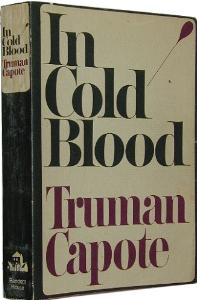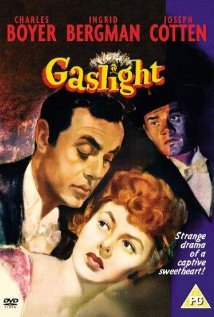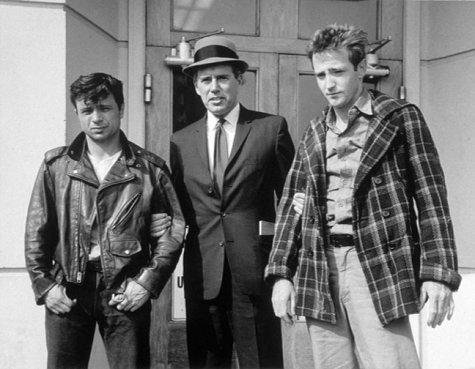By Film Noir Blonde and Mike Wilmington
The Noir File is FNB’s guide to classic film noir, neo-noir and pre-noir from the schedule of Turner Classic Movies (TCM), which broadcasts them uncut and uninterrupted. The times are Eastern Standard and (Pacific Standard).
Pick of the Week
 “In Cold Blood” (1967, Richard Brooks). Tuesday, Feb. 25; 10:15 a.m. (7:15 a.m.). It was one of the literary sensations of the mid-‘60s: Truman Capote’s “non-fiction novel,” “In Cold Blood” – a beautifully written study of two drifter ex-con killers, Dick Hickok and Perry Smith, who murder an ordinary, nice Kansas family, the Clutters, while robbing their home. After the crime, the murderers are pursued through bleak Midwestern landscapes by the tenacious F.B.I. detective Alvin Dewey.
“In Cold Blood” (1967, Richard Brooks). Tuesday, Feb. 25; 10:15 a.m. (7:15 a.m.). It was one of the literary sensations of the mid-‘60s: Truman Capote’s “non-fiction novel,” “In Cold Blood” – a beautifully written study of two drifter ex-con killers, Dick Hickok and Perry Smith, who murder an ordinary, nice Kansas family, the Clutters, while robbing their home. After the crime, the murderers are pursued through bleak Midwestern landscapes by the tenacious F.B.I. detective Alvin Dewey.
Capote researched the book with his childhood friend, novelist Harper Lee (“To Kill a Mockingbird“), digging deeply and raptly into both the blameless family who were killed and the misfit outlaws who killed them, in cold blood. It’s a perfectly shaped but deeply disturbing book, and more than a few critics have suggested that Capote was a bit in love with one of the murderers, Perry Smith, and a bit over-fascinated with Perry’s and Dick’s under-the radar, maybe covertly homo-erotic criminal life.
Maybe. Maybe not. In the film, which was written and directed by Richard Brooks (”The Blackboard Jungle,“ “Elmer Gantry”), actor John Forsythe, an Alfred Hitchcock favorite, plays detective Dewey, and two young on-the-rise actors play (superbly) Dick and Perry. Scott Wilson absolutely nails crew-cut conman Dick’s jock veneer and sharpie amorality and Robert Blake catches Perry’s deadly sadness and wounded grace – like a bird trembling in a hand.
Brooks is a more self-consciously tough writer than Capote and the movie is different, and harder, in tone and mood, than its source – though Capote said he loved it, and Conrad Hall’s stunning black and white cinematography of roads and small towns and the icy faces of the two killers, is a good equivalent for Capote’s lyrical prose.
Hall’s photography, along with Wilson‘s and Blake‘s performances, make “In Cold Blood” a major neo-noir. It‘s also a fine adaptation of an unforgettable book, and one of the great true-crime movies – even though it’s hard to accept the deep-voiced, cynical-sounding Paul Stewart, one of the old Orson Welles Mercury stock company, as the movie‘s writer-figure, its equivalent for Capote. Perhaps they should have cast Truman himself in the role. Ham that he was, he probably would have taken it. The back-story of how Capote and Harper Lee researched the book, provides the subject matter for two more good neo-noirs: the biopics “Infamous“ (2006), in which Toby Jones plays Capote, and “Capote” (2005), in which Philip Seymour Hoffman plays him.
Somewhat eerily, “In Cold Blood” has a number of bizarre links to the great, dark gold-hunting saga, “The Treasure of the Sierra Madre.” (See below.) It was Perry Smith’s favorite movie, and he watched it repeatedly. Perry also thought that Walter Huston, in his “Treasure” role of grizzled old prospector Howard, was the dead image of Perry’s own father.
Additionally, actor Robert Blake (Perry in the 1967 film) as a child played the little Mexican boy who sells Bogart the winning lottery ticket in “Treasure.”
Friday, Feb. 21
 1 a.m. (10 p.m.); “Gaslight” (1944, George Cukor). With Ingrid Bergman, Charles Boyer, Joseph Cotten and Angela Lansbury. Reviewed in FNB on August 25, 2012.
1 a.m. (10 p.m.); “Gaslight” (1944, George Cukor). With Ingrid Bergman, Charles Boyer, Joseph Cotten and Angela Lansbury. Reviewed in FNB on August 25, 2012.
Saturday, Feb. 22
3:30 a.m. (12:30 a.m.): “The Treasure of the Sierra Madre” (1948, John Huston). With Humphrey Bogart, Walter Huston and Tim Holt. Reviewed in FNB on November 3, 2012.
Monday, Feb. 24
1:15 a.m. (10:15 p.m.): “The Spy Who Came in from the Cold,” (1965, Martin Ritt). Richard Burton is sodden and defeated Alec Leamas, a seedy, sad British intelligence man trapped in a world of cruelty, deception and betrayal. This is international intrigue as the game is really played. In the ‘60s, this was the anti-Bond spy movie, based on author (and ex-intelligence man) John le Carre’s first big critical-commercial success. It’s a meticulous portrait of unheroic men and women in an unheroic profession, amid a Cold War that may kill them, and almost certainly will debase them. Shot in monochrome in a sea of grays, with a tremendous cast: Burton (at his best), Oskar Werner, Claire Bloom, Cyril Cusack, Michael Hordern, Sam Wanamaker and Bernard Lee (James Bond’s “M,” trading with the enemy).
Tuesday, Feb. 23
8:30 a.m. (5:30 a.m.) “Lifeboat” (1944, Alfred Hitchcock). With Tallulah Bankhead, Walter Slezak and John Hodiak. Reviewed in FNB on Jan. 10, 2014.
10: 15 a.m. (7:15 a.m.): “In Cold Blood” See Pick of the Week.






![people_who_eat_darkness_-_cover[1]](http://www.filmnoirblonde.com/wp-content/uploads/2012/07/people_who_eat_darkness_-_cover12-195x300.jpg)





From FNB readers